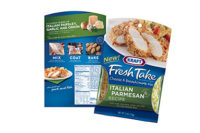
Jerry Dryer
While milk-based product sales are registering some respectable increases in the United States, American manufacturers are finding huge opportunities in markets around the world.
Yogurt sales in the United States have been scoring double-digit growth for more than a decade and cheese sales have marched steadily higher, but these products have been exceptions to the rule.
Beverage milk sales have moved lower each year for most of the past five decades when measured on a per capita basis. Most other dairy products typically register yawns during the annual updates on sales.

Much of the U.S. export sales growth over the past decade has been driven by ingredient sales-dairy products destined for further manufacturing or for use as animal feed. But consumer-ready products are also being moved to customers and consumers around the world.
Various whey products, nonfat dry milk, skim milk powder and lactose capture most of the headlines for stories about exports, but fluid milk, cheese, ice cream, yogurt and infant formula are also finding customers outside of the United States.
During 2006, we moved $1.89 billion worth of milk and dairy products to customers outside of the United States. This is double the value moved during 1999 when a fairly large percentage of the shipments were actually given away or subsidized by the government. Last year, Cooperatives Working Together (a farmer-funded program) paid bonuses to help move a small percentage of the exports shipped.
For example, CWT helped 13.9 million pounds of cheese leave the country; exports totaled 157 million pounds. Whole milk powder shipments were aided and a large percentage of butterfat exported required help, but all other exports were unaided and commercial. Less than 2% of the 2006 exports were assisted either by the government or CWT.
For perspective: Cheese exports last year moved abroad at an average price of about $1.56 per pound; the block cheese price at the Chicago Mercantile Exchange averaged $1.2385.
By in large, U.S. exports are ingredients; U.S. imports are valued-added cheeses and other pricey products. So, the dollar value of exports continued to lag that of imports. Volume is another story.
On a milk solids basis, U.S. dairy exports totaled 2.092 billion pounds and accounted for 9.3% of this country’s milk production. On a milk solids basis, exports were more than double the volume of imports.
Just a few years ago, Uncle Sam was buying and removing surplus nonfat dry milk from the marketplace to help support milk prices. Some years, hundreds of millions of pounds were stashed away in caves near Kansas City and in other crooks and crannies around the country.
For the past three years, U.S. exports of nonfat dry milk and skim milk powder have totaled at least 600 million pounds annually; 632 million pounds during 2006. This represents about 42% of the dried nonfat milk powder produced during the year. Of the 1.1 billion pounds of dry whey manufactured in the United States last year, 500 million pounds were sent to customers around the world.
Export volumes could have been greater; we simply didn’t have enough product to fill all of the orders. World demand was so strong that domestic trade faced shortages; shortages that persist to this day.
With world economies in a major growth mode, this will likely be the case for many years to come. Milk producers in this country should take a hard look at their schizophrenia. Are they going to kill cows and shrink their business or make milk and market products for a growing world appetite? They can’t have it both ways for much longer.
Personally, I opt for a growing milk production and dairy export business. Hopefully, you agree. If not, ask some of the millions who have been “downsized” out of other businesses. Then, you too, will opt for growth.
There is a home away from home for U.S. dairy products.
For archived Jerry Dryer articles visitwww.dairyfoods.com.
